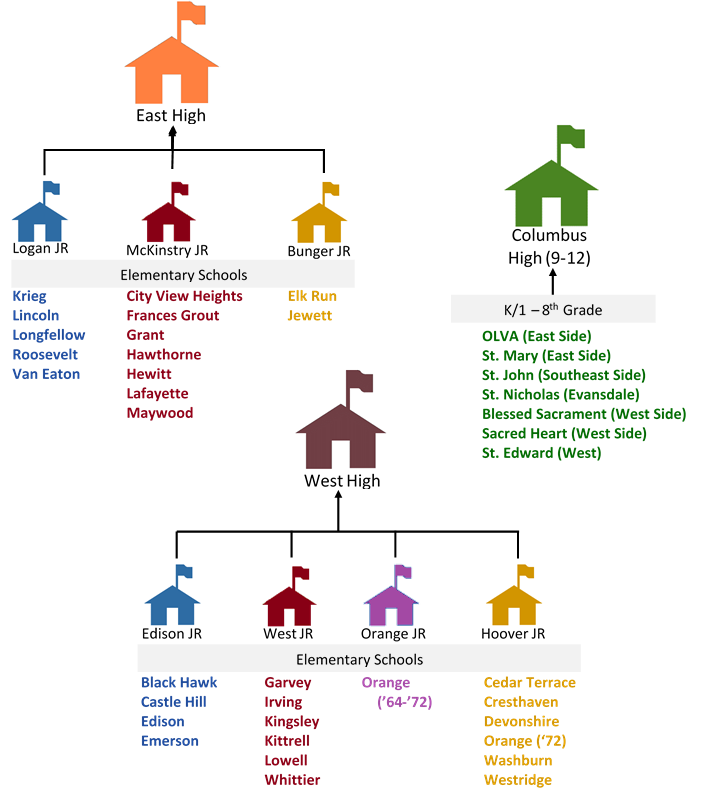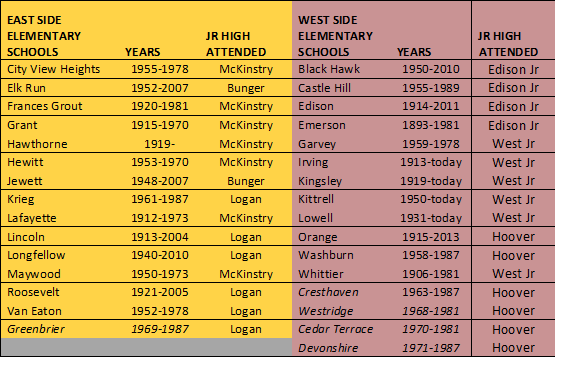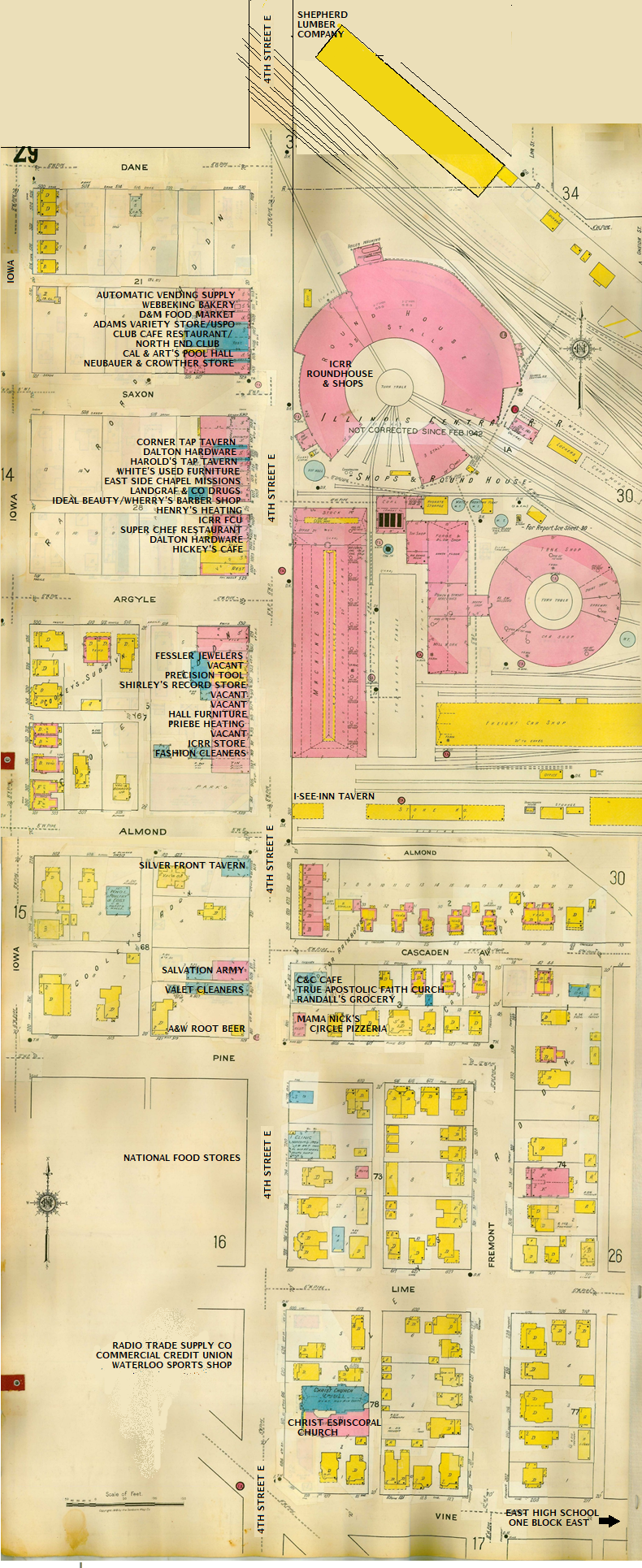The TBB manuscript was officially completed at 10:10 a.m., Friday, 13 April 2018. Followed by a celebratory dinner . . . .
Next steps: Format manuscript for publishing, receive a review copy, make any final changes not caught in formatting or additions. Resubmit. PUBLISH. Timetable. Uh, when it’s done? 
In the meantime, here are some of the materials which have been edited out . . . .
From Chapter 04, Too Many Cooks. Dallas Cowboy star running back Don Perkins is known in Waterloo as the first black student to attend West High in the mid-1950s, although he lived on the East Side. It was and is generally perceived the BOE allowed this because of his athletic ability. He was elected student council president his senior year. The long-time perception has been and is his election was because he was a star athlete at West.
None of these perceptions are based in fact.
The fourth of eight children, Perkins’ family lived in the Riverview subdivision at the end of Mitchell Street on the West Side, adjacent to the Mitchell sand pits. It was a mixed neighborhood of mostly poor whites and a few black families. People don’t remember or know he attended elementary and junior high school on the West Side, as well. When his mother died, Perkins was a sophomore at West. His father moved the family to the East Side, but petitioned the school district and Perkins was allowed to complete high school at West.
His three older siblings, among other blacks, had attended West Side elementary and junior high schools and West High school before him.
A good student and active in the school, Perkins was elected vice president of the student government as a junior, before his athletic reputation had been fully established in his final year at West.
Perkins earned eight letters at West, four each in football and track as a sprinter. Playing both halfback and on defense, the team went undefeated his senior year, ending with a 20-12 win over East; Perkins was named to the Big Six Conference and Iowa state first teams. He was track team captain by the time he was a junior.
He set 12 records as a three-year halfback starter at the University of New Mexico and returned kickoffs. where he where he was a three-time All-Skyline conference player from 1957–1959 Skyline Sophomore of the Year in 1957. In 1958, he led the nation in kickoff returns. His number 43 was the first one retired in UNM history when he completed his pro career.
The Dallas Cowboys, which had been admitted to the NFL too late to participate in the 1960 draft, signed Perkins to a personal services contract as part of the franchise’s first team, which included Tom Landry, Tex Schramm, Gil Brandt, Dan Reeves and Pettis Norman. He missed the Cowboys’ inaugural season with a broken foot suffered in a practice, but was rookie of the year and named to the Pro Bowl. The first Dallas Cowboy to rush for 100 yards in a game with 17 carries against the Minnesota Vikings for 108 yards, Perkins was the Cowboys’ top rusher six of his eight seasons and led them in touchdowns in four of them. He was selected to six Pro Bowls and was All-Pro once.
In 1968, Perkins was involved in getting the Cowboys to abandon the practice of segregating players when traveling to hotels.
Perkins retired at age 31 at the start of the 1969 season, the 5th all-time leading NFL rusher at the time. Also known for his blocking ability, he’s third on the Cowboys’ career rushing list behind Emmitt Smith and Tony Dorsett. He’s also one of 20 members of the team’s Ring of Honor along with Landry and Schramm, who are also members of the NFL Hal of Fame. PHOTO: Don Perkins. 1975 Sports Hall of Fame Inductee. New Mexico Sports Hall of Fame. Retrieved from http://nmshof.com/don-perkins/.
Replaced with — Dallas Cowboy star running back Don Perkins is known in Waterloo as the first black student to attend West High in the mid-1950s, although he lived on the East Side. It was and is generally perceived the BOE allowed this because of his athletic ability. He was elected student council president his senior year. The long-time story was and is he was elected because he was a star athlete at West.
None of these perceptions are based in fact. His three older siblings, among other blacks, had attended West Side elementary and junior high schools and West High school before him.
A good student and active in the school, Perkins was elected vice president of the student government as a junior, before his athletic reputation had been fully established in his final year at West.
The Perkins story is relevant, because of the perception there were no black students in the West Side public elementary, junior high and high schools until the 1970s, and he broke the barrier.
From Chapter 09 Post-Storm Surge: Athletes were Elites. Sports is a stronger theme in ERA 3 as desegregation broke up the long-standing championship junior high and high school teams.
Going into my senior season, you talk about the pressure of playing football. You either thrive on it or you run away from it. We’re playing football every week. Four games in September, four games in October. There’s this Des Moines Dowling team which is really good. They started No. 1 and East started No. 2 [in the polls for the mythical state championship.] And we’re chasing them every week. One week, they barely beat somebody and we beat somebody pretty good, so we got vaulted to No. 1. So, now every week, you not only need to win but you needed to win big or you might drop out of No. 1. And at the end of the season if they you’re not voted No. 1, there was nothing you could do about it even if you were undefeated. So, there was pressure to win to keep the streak alive and to winning big. [EHS 71 WM]
The Trojans had been undefeated since 1962, eight seasons.
[Continued] As the season went on, West had a really good season. As they continued to win, we continued to win. People began to look at the end of the season and said, “What if East and West ended up undefeated at the end of season and East was still No. 1?” West started creeping up in the polls. At the end of the season we were both 8-0. It was the first time in the history of the 57-game rivalry both teams were undefeated and untied when they played each other in the traditional last game of the season. We were No. 1 and they were No. 3. And basically, the winner would be the mythical state champs. West was 17-1-1 over two years; their only loss was to East. And we’re going in to play these guys.
It was called “. . . one of, if not the biggest high school football game ever played in this state. . . .” by the Waterloo Daily Courier. The game was sold out a half an hour after the 7,500 tickets went on sale [by landline in the days without online sales or cell phones], including roughly 2,900 general admission. East sold its 750 reserved $2 seats in half an hour while West reported its 700 tickets were sold in 10 minutes.
The BOE voted to keep the game at Sloane Wallace Stadium where the two teams both played their home games rather than move it to Latham Stadium at UNI which had more permanent and bleachers seats, with room to add temporary bleachers.
With a nod to the disturbance at the East game in 1968 against St. Joseph’s Academy of Westchester, IL, which resulted in a permanent change to day games for East High, the school board explained, “. . . the players, students, faculty and parents have demonstrated the spirit which is the basis for an excellent athletic program . . . . [which] was a major consideration. . . .” The board also authorized 12 additional lights for the field for the game.
(Continued) The game had built to the point there were over 10,000 people there and KWWL televised its first ever high school football game. The Columbus-Cedar Falls game which normally was played the same night was moved to Thursday to get it out of the way. So, those fans could either come and watch our game or see it I live on TV.
The game was at Sloane Wallace Stadium. We leave East and get on one-way East 5th Street and go straight down over there on the buses. The crowd and everything was unbelievable.
We had 47 straight wins and we wanted to keep it going with our fifth straight state title. To lose to crosstown rival West would just have been unbelievable. When I was in college, we might lose a conference game and come back on campus and be in the dorm and we hear about it a little bit there. When you’re in high school and you come back and you’ve lost, you hear about it. I’d have to go back to the same high school and listen to everybody in the class back and forth.
The pressure permeated to other people. For example, my mom worked at a store downtown. Her co-workers knew her kid played at East and their kids played at West. And the jawing would go back and forth a little bit. My dad worked at Deere’s and had a lot of Deere workers going back and forth with him. So, now you’re responsible for your mom and dad having to deal with it if you lost. Thank God we won, 20-9.
There were no blacks that went to West at that time, so as a white player, I played against other white players. I had the biggest chip on my shoulders to beat them because of their arrogance and what they thought they were at the time. Everyone was happy to win, but the release was the big thing. I told the juniors, “Good luck next year, man. It’s now on you.” [EHS 71 WM]
Thanks again for being a follower, providing updates and insights, keeping in touch, encouraging. I’ll keep you up to date on publishing and launch in Waterloo . . . . I hope the week exceeds all of your expectations. . . . We’re under a tornado watch here in paradise until 6 p.m. . . . .

 TO MAKE SURE THAT YOUR EMAIL IS SORTED TO THE RIGHT FOLDER, use “
TO MAKE SURE THAT YOUR EMAIL IS SORTED TO THE RIGHT FOLDER, use “
 nick
nick











 What 10 days of compiling, writing editing and formatting roughly 8-10 hours each day starting NLT 6 am does . . . Sitting inside with a hat on and one of my favorite pipes which I haven’t lit since we got Andrew in 1989 or since smoking was ruled illegal because it’s bad for my health . . . .
What 10 days of compiling, writing editing and formatting roughly 8-10 hours each day starting NLT 6 am does . . . Sitting inside with a hat on and one of my favorite pipes which I haven’t lit since we got Andrew in 1989 or since smoking was ruled illegal because it’s bad for my health . . . .
 The link below is to a video about the last couple of weeks and some trivia from 1963 when The Bridge Between story begins; 1968, which is in the middle of the decade; and 1973, which is the 10th year. Click on the link and YouTube should open in a separate tab.
The link below is to a video about the last couple of weeks and some trivia from 1963 when The Bridge Between story begins; 1968, which is in the middle of the decade; and 1973, which is the 10th year. Click on the link and YouTube should open in a separate tab.

 Nick
Nick